Research Proposal: Impact of Rewards on Employee Turnover in IT
VerifiedAdded on 2019/09/22
|19
|3945
|486
Report
AI Summary
This research proposal investigates the relationship between reward systems and employee turnover, specifically within the IT industry, with a case study on Mannai Corporation in Qatar. The study aims to determine how reward systems, including both monetary and non-monetary incentives, influence employee retention and job satisfaction. The proposal includes a literature review exploring the importance of rewards, the impact of reward systems on turnover, and the roles of various types of rewards. The research methodology outlines a qualitative approach, detailing the research methods, strategy, design, and ethical considerations. The research seeks to address specific questions regarding the impact of reward systems, job satisfaction, and their interrelationship, with the ultimate goal of providing recommendations for minimizing employee turnover within the IT sector in Qatar. The study emphasizes the importance of competitive compensation, recognition, and career development opportunities in retaining skilled employees and maintaining a stable workforce.
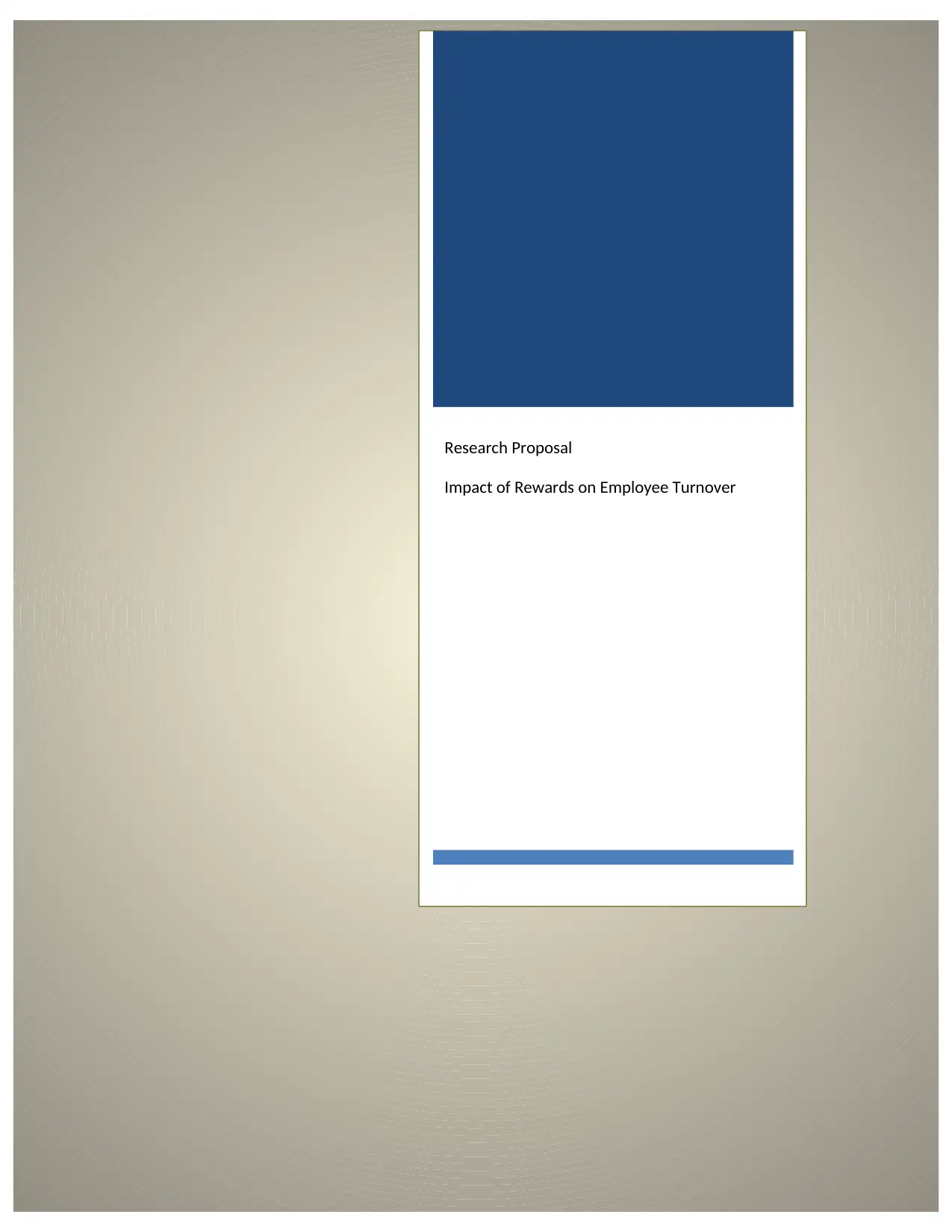
Research Proposal
Impact of Rewards on Employee Turnover
Impact of Rewards on Employee Turnover
Paraphrase This Document
Need a fresh take? Get an instant paraphrase of this document with our AI Paraphraser
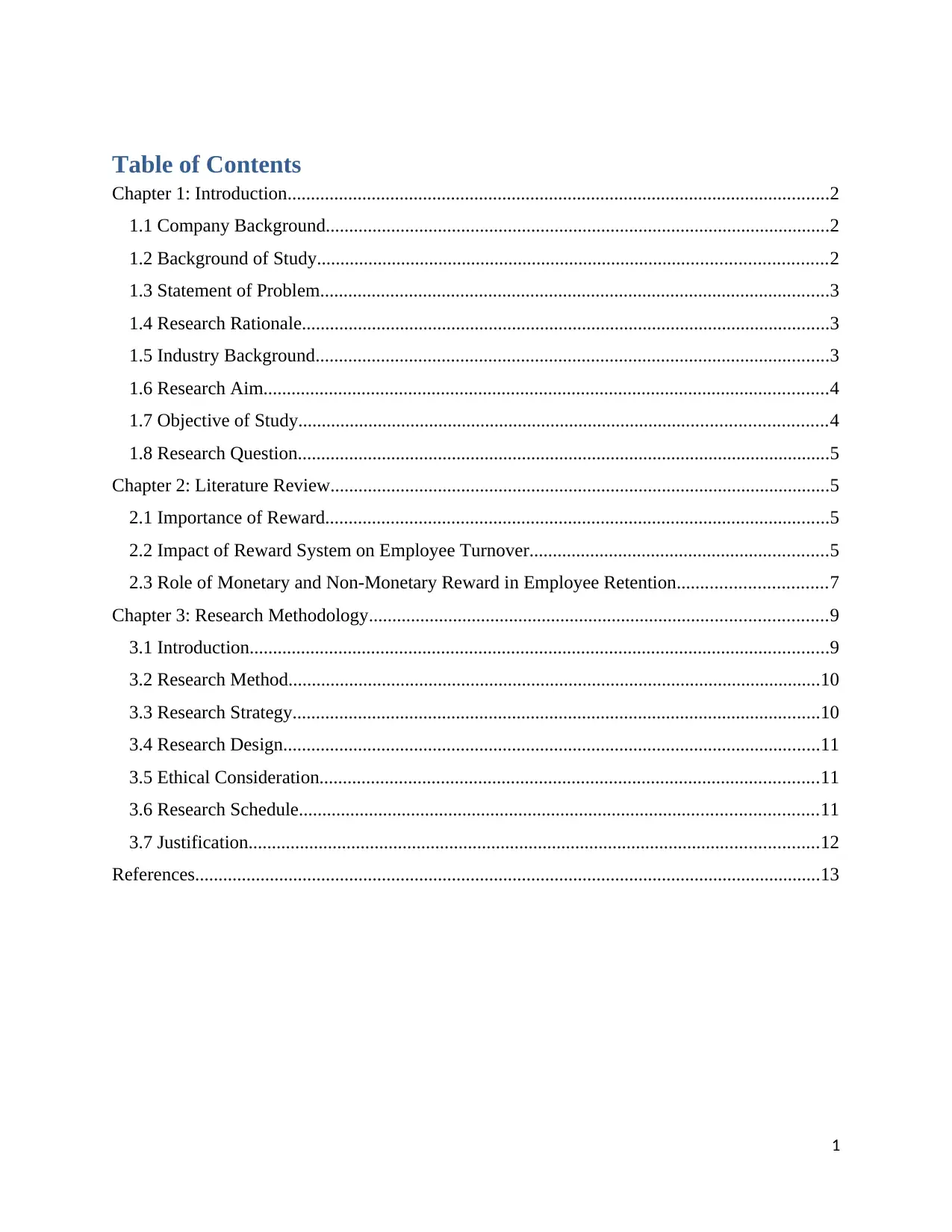
Table of Contents
Chapter 1: Introduction....................................................................................................................2
1.1 Company Background............................................................................................................2
1.2 Background of Study.............................................................................................................2
1.3 Statement of Problem.............................................................................................................3
1.4 Research Rationale.................................................................................................................3
1.5 Industry Background..............................................................................................................3
1.6 Research Aim.........................................................................................................................4
1.7 Objective of Study.................................................................................................................4
1.8 Research Question..................................................................................................................5
Chapter 2: Literature Review...........................................................................................................5
2.1 Importance of Reward............................................................................................................5
2.2 Impact of Reward System on Employee Turnover................................................................5
2.3 Role of Monetary and Non-Monetary Reward in Employee Retention................................7
Chapter 3: Research Methodology..................................................................................................9
3.1 Introduction............................................................................................................................9
3.2 Research Method..................................................................................................................10
3.3 Research Strategy.................................................................................................................10
3.4 Research Design...................................................................................................................11
3.5 Ethical Consideration...........................................................................................................11
3.6 Research Schedule...............................................................................................................11
3.7 Justification..........................................................................................................................12
References......................................................................................................................................13
1
Chapter 1: Introduction....................................................................................................................2
1.1 Company Background............................................................................................................2
1.2 Background of Study.............................................................................................................2
1.3 Statement of Problem.............................................................................................................3
1.4 Research Rationale.................................................................................................................3
1.5 Industry Background..............................................................................................................3
1.6 Research Aim.........................................................................................................................4
1.7 Objective of Study.................................................................................................................4
1.8 Research Question..................................................................................................................5
Chapter 2: Literature Review...........................................................................................................5
2.1 Importance of Reward............................................................................................................5
2.2 Impact of Reward System on Employee Turnover................................................................5
2.3 Role of Monetary and Non-Monetary Reward in Employee Retention................................7
Chapter 3: Research Methodology..................................................................................................9
3.1 Introduction............................................................................................................................9
3.2 Research Method..................................................................................................................10
3.3 Research Strategy.................................................................................................................10
3.4 Research Design...................................................................................................................11
3.5 Ethical Consideration...........................................................................................................11
3.6 Research Schedule...............................................................................................................11
3.7 Justification..........................................................................................................................12
References......................................................................................................................................13
1
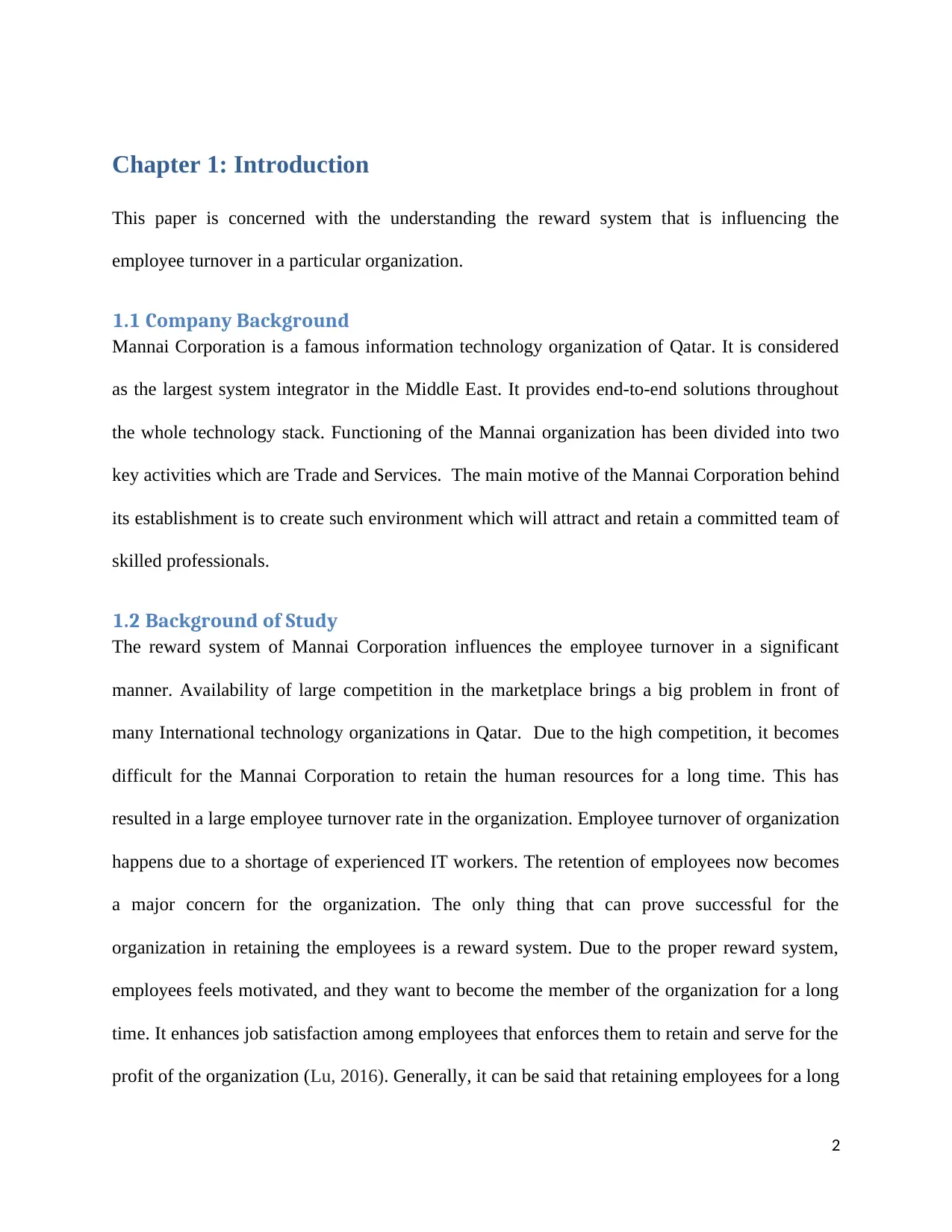
Chapter 1: Introduction
This paper is concerned with the understanding the reward system that is influencing the
employee turnover in a particular organization.
1.1 Company Background
Mannai Corporation is a famous information technology organization of Qatar. It is considered
as the largest system integrator in the Middle East. It provides end-to-end solutions throughout
the whole technology stack. Functioning of the Mannai organization has been divided into two
key activities which are Trade and Services. The main motive of the Mannai Corporation behind
its establishment is to create such environment which will attract and retain a committed team of
skilled professionals.
1.2 Background of Study
The reward system of Mannai Corporation influences the employee turnover in a significant
manner. Availability of large competition in the marketplace brings a big problem in front of
many International technology organizations in Qatar. Due to the high competition, it becomes
difficult for the Mannai Corporation to retain the human resources for a long time. This has
resulted in a large employee turnover rate in the organization. Employee turnover of organization
happens due to a shortage of experienced IT workers. The retention of employees now becomes
a major concern for the organization. The only thing that can prove successful for the
organization in retaining the employees is a reward system. Due to the proper reward system,
employees feels motivated, and they want to become the member of the organization for a long
time. It enhances job satisfaction among employees that enforces them to retain and serve for the
profit of the organization (Lu, 2016). Generally, it can be said that retaining employees for a long
2
This paper is concerned with the understanding the reward system that is influencing the
employee turnover in a particular organization.
1.1 Company Background
Mannai Corporation is a famous information technology organization of Qatar. It is considered
as the largest system integrator in the Middle East. It provides end-to-end solutions throughout
the whole technology stack. Functioning of the Mannai organization has been divided into two
key activities which are Trade and Services. The main motive of the Mannai Corporation behind
its establishment is to create such environment which will attract and retain a committed team of
skilled professionals.
1.2 Background of Study
The reward system of Mannai Corporation influences the employee turnover in a significant
manner. Availability of large competition in the marketplace brings a big problem in front of
many International technology organizations in Qatar. Due to the high competition, it becomes
difficult for the Mannai Corporation to retain the human resources for a long time. This has
resulted in a large employee turnover rate in the organization. Employee turnover of organization
happens due to a shortage of experienced IT workers. The retention of employees now becomes
a major concern for the organization. The only thing that can prove successful for the
organization in retaining the employees is a reward system. Due to the proper reward system,
employees feels motivated, and they want to become the member of the organization for a long
time. It enhances job satisfaction among employees that enforces them to retain and serve for the
profit of the organization (Lu, 2016). Generally, it can be said that retaining employees for a long
2
⊘ This is a preview!⊘
Do you want full access?
Subscribe today to unlock all pages.

Trusted by 1+ million students worldwide
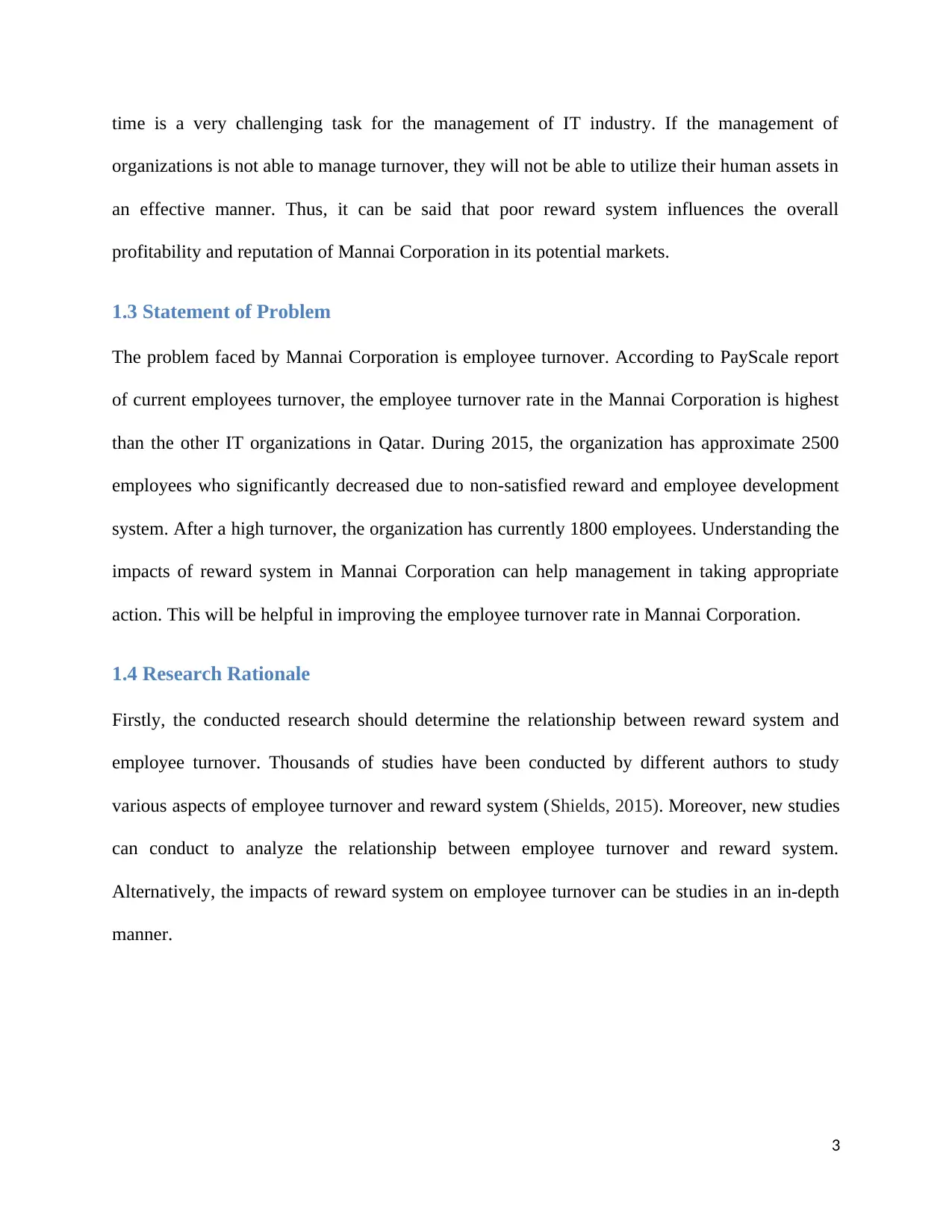
time is a very challenging task for the management of IT industry. If the management of
organizations is not able to manage turnover, they will not be able to utilize their human assets in
an effective manner. Thus, it can be said that poor reward system influences the overall
profitability and reputation of Mannai Corporation in its potential markets.
1.3 Statement of Problem
The problem faced by Mannai Corporation is employee turnover. According to PayScale report
of current employees turnover, the employee turnover rate in the Mannai Corporation is highest
than the other IT organizations in Qatar. During 2015, the organization has approximate 2500
employees who significantly decreased due to non-satisfied reward and employee development
system. After a high turnover, the organization has currently 1800 employees. Understanding the
impacts of reward system in Mannai Corporation can help management in taking appropriate
action. This will be helpful in improving the employee turnover rate in Mannai Corporation.
1.4 Research Rationale
Firstly, the conducted research should determine the relationship between reward system and
employee turnover. Thousands of studies have been conducted by different authors to study
various aspects of employee turnover and reward system (Shields, 2015). Moreover, new studies
can conduct to analyze the relationship between employee turnover and reward system.
Alternatively, the impacts of reward system on employee turnover can be studies in an in-depth
manner.
3
organizations is not able to manage turnover, they will not be able to utilize their human assets in
an effective manner. Thus, it can be said that poor reward system influences the overall
profitability and reputation of Mannai Corporation in its potential markets.
1.3 Statement of Problem
The problem faced by Mannai Corporation is employee turnover. According to PayScale report
of current employees turnover, the employee turnover rate in the Mannai Corporation is highest
than the other IT organizations in Qatar. During 2015, the organization has approximate 2500
employees who significantly decreased due to non-satisfied reward and employee development
system. After a high turnover, the organization has currently 1800 employees. Understanding the
impacts of reward system in Mannai Corporation can help management in taking appropriate
action. This will be helpful in improving the employee turnover rate in Mannai Corporation.
1.4 Research Rationale
Firstly, the conducted research should determine the relationship between reward system and
employee turnover. Thousands of studies have been conducted by different authors to study
various aspects of employee turnover and reward system (Shields, 2015). Moreover, new studies
can conduct to analyze the relationship between employee turnover and reward system.
Alternatively, the impacts of reward system on employee turnover can be studies in an in-depth
manner.
3
Paraphrase This Document
Need a fresh take? Get an instant paraphrase of this document with our AI Paraphraser
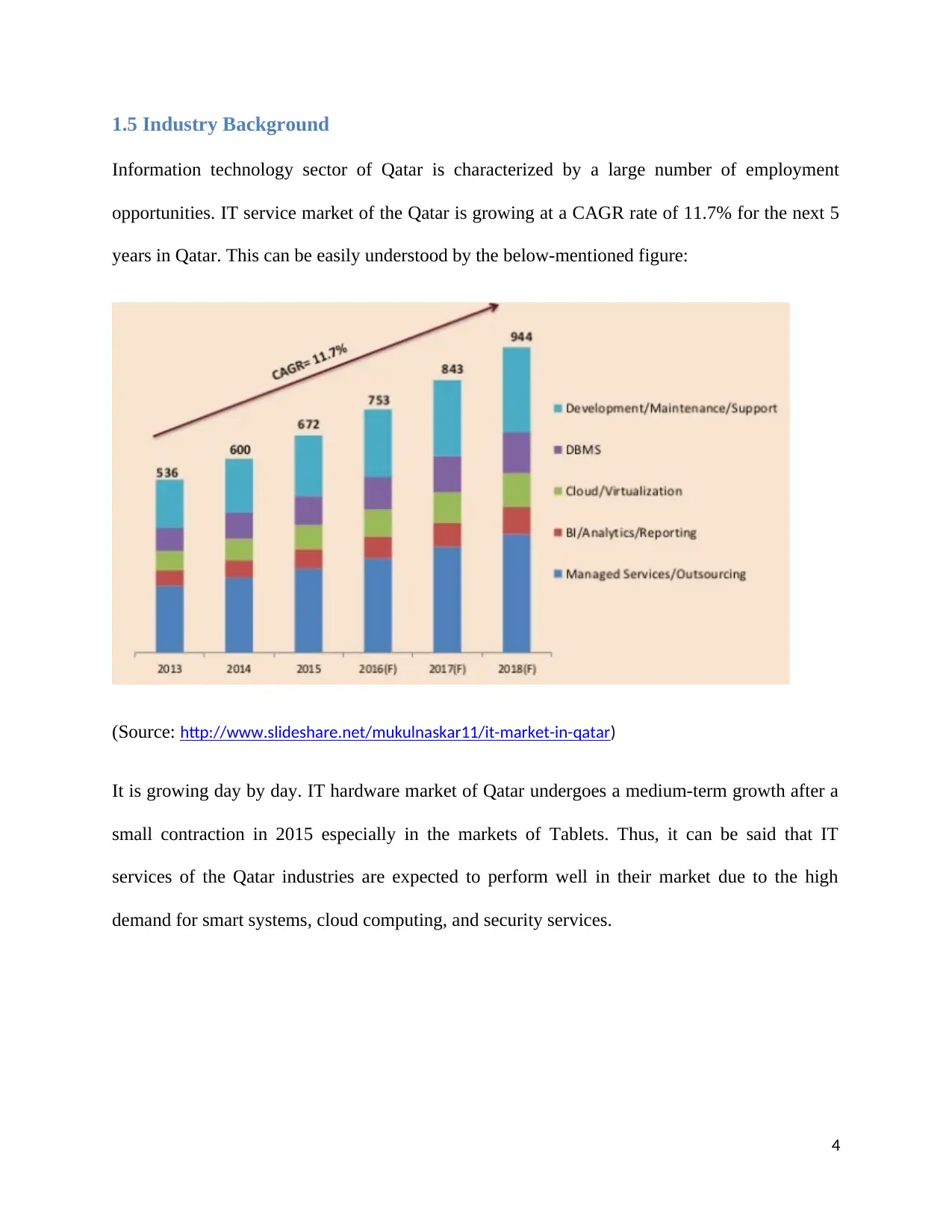
1.5 Industry Background
Information technology sector of Qatar is characterized by a large number of employment
opportunities. IT service market of the Qatar is growing at a CAGR rate of 11.7% for the next 5
years in Qatar. This can be easily understood by the below-mentioned figure:
(Source: http://www.slideshare.net/mukulnaskar11/it-market-in-qatar)
It is growing day by day. IT hardware market of Qatar undergoes a medium-term growth after a
small contraction in 2015 especially in the markets of Tablets. Thus, it can be said that IT
services of the Qatar industries are expected to perform well in their market due to the high
demand for smart systems, cloud computing, and security services.
4
Information technology sector of Qatar is characterized by a large number of employment
opportunities. IT service market of the Qatar is growing at a CAGR rate of 11.7% for the next 5
years in Qatar. This can be easily understood by the below-mentioned figure:
(Source: http://www.slideshare.net/mukulnaskar11/it-market-in-qatar)
It is growing day by day. IT hardware market of Qatar undergoes a medium-term growth after a
small contraction in 2015 especially in the markets of Tablets. Thus, it can be said that IT
services of the Qatar industries are expected to perform well in their market due to the high
demand for smart systems, cloud computing, and security services.
4
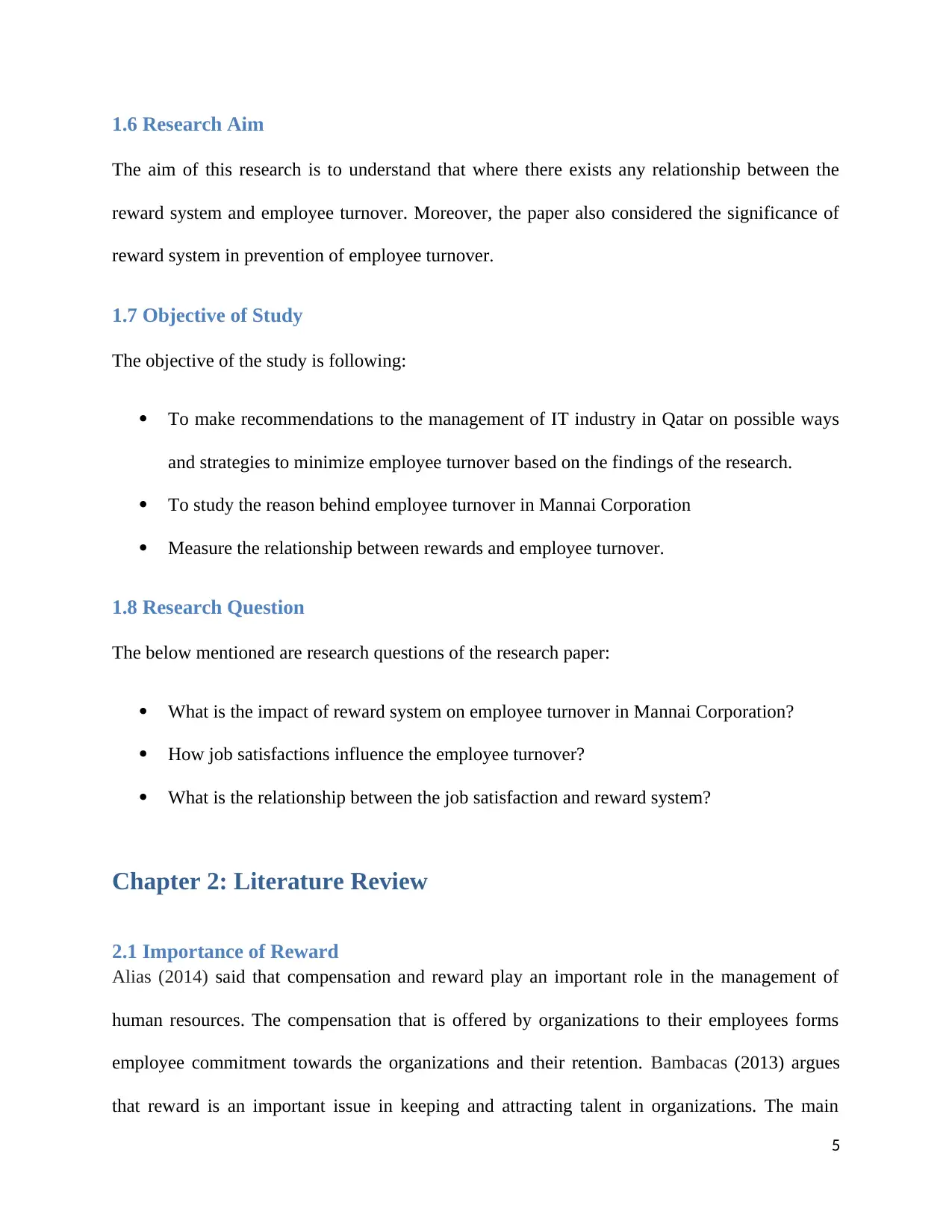
1.6 Research Aim
The aim of this research is to understand that where there exists any relationship between the
reward system and employee turnover. Moreover, the paper also considered the significance of
reward system in prevention of employee turnover.
1.7 Objective of Study
The objective of the study is following:
To make recommendations to the management of IT industry in Qatar on possible ways
and strategies to minimize employee turnover based on the findings of the research.
To study the reason behind employee turnover in Mannai Corporation
Measure the relationship between rewards and employee turnover.
1.8 Research Question
The below mentioned are research questions of the research paper:
What is the impact of reward system on employee turnover in Mannai Corporation?
How job satisfactions influence the employee turnover?
What is the relationship between the job satisfaction and reward system?
Chapter 2: Literature Review
2.1 Importance of Reward
Alias (2014) said that compensation and reward play an important role in the management of
human resources. The compensation that is offered by organizations to their employees forms
employee commitment towards the organizations and their retention. Bambacas (2013) argues
that reward is an important issue in keeping and attracting talent in organizations. The main
5
The aim of this research is to understand that where there exists any relationship between the
reward system and employee turnover. Moreover, the paper also considered the significance of
reward system in prevention of employee turnover.
1.7 Objective of Study
The objective of the study is following:
To make recommendations to the management of IT industry in Qatar on possible ways
and strategies to minimize employee turnover based on the findings of the research.
To study the reason behind employee turnover in Mannai Corporation
Measure the relationship between rewards and employee turnover.
1.8 Research Question
The below mentioned are research questions of the research paper:
What is the impact of reward system on employee turnover in Mannai Corporation?
How job satisfactions influence the employee turnover?
What is the relationship between the job satisfaction and reward system?
Chapter 2: Literature Review
2.1 Importance of Reward
Alias (2014) said that compensation and reward play an important role in the management of
human resources. The compensation that is offered by organizations to their employees forms
employee commitment towards the organizations and their retention. Bambacas (2013) argues
that reward is an important issue in keeping and attracting talent in organizations. The main
5
⊘ This is a preview!⊘
Do you want full access?
Subscribe today to unlock all pages.

Trusted by 1+ million students worldwide
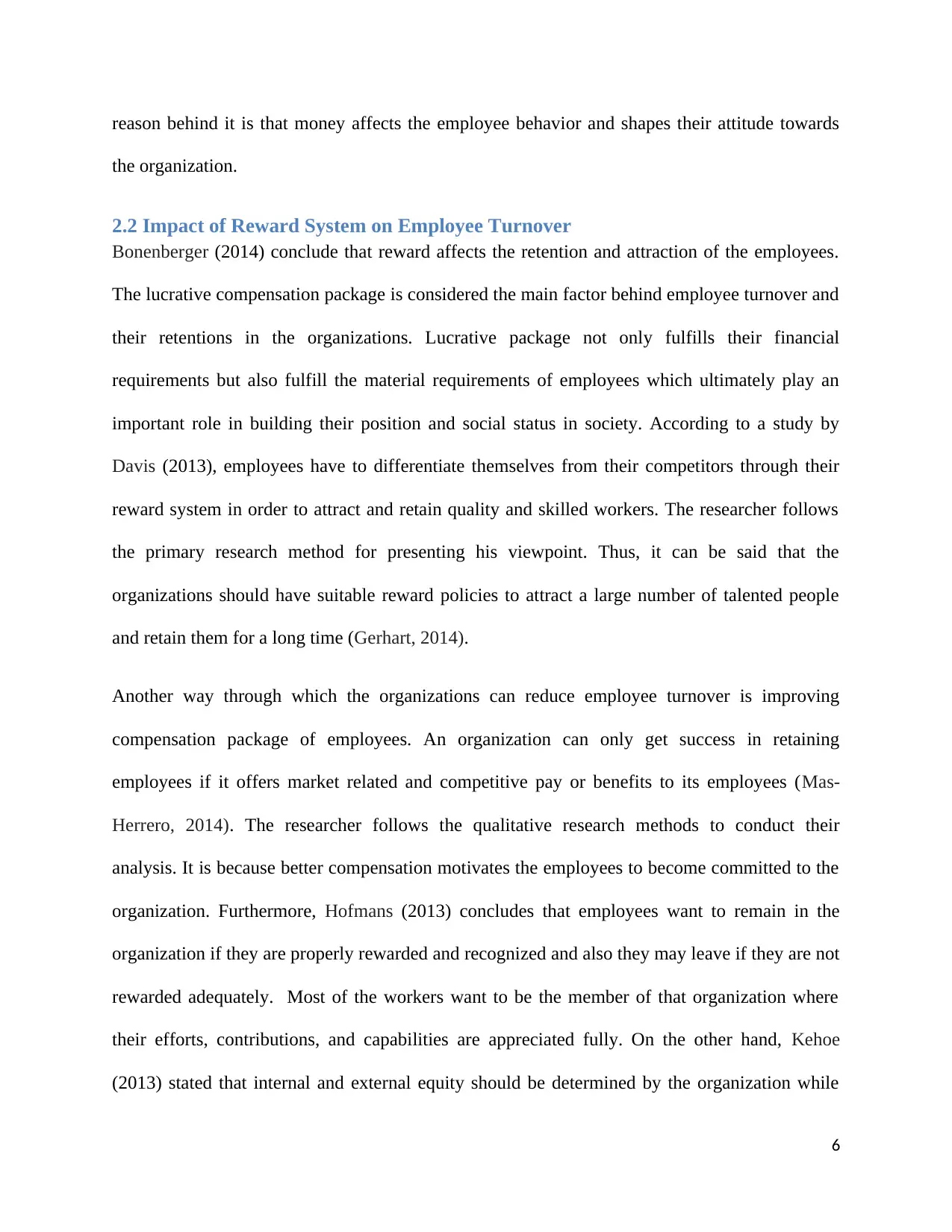
reason behind it is that money affects the employee behavior and shapes their attitude towards
the organization.
2.2 Impact of Reward System on Employee Turnover
Bonenberger (2014) conclude that reward affects the retention and attraction of the employees.
The lucrative compensation package is considered the main factor behind employee turnover and
their retentions in the organizations. Lucrative package not only fulfills their financial
requirements but also fulfill the material requirements of employees which ultimately play an
important role in building their position and social status in society. According to a study by
Davis (2013), employees have to differentiate themselves from their competitors through their
reward system in order to attract and retain quality and skilled workers. The researcher follows
the primary research method for presenting his viewpoint. Thus, it can be said that the
organizations should have suitable reward policies to attract a large number of talented people
and retain them for a long time (Gerhart, 2014).
Another way through which the organizations can reduce employee turnover is improving
compensation package of employees. An organization can only get success in retaining
employees if it offers market related and competitive pay or benefits to its employees (Mas-
Herrero, 2014). The researcher follows the qualitative research methods to conduct their
analysis. It is because better compensation motivates the employees to become committed to the
organization. Furthermore, Hofmans (2013) concludes that employees want to remain in the
organization if they are properly rewarded and recognized and also they may leave if they are not
rewarded adequately. Most of the workers want to be the member of that organization where
their efforts, contributions, and capabilities are appreciated fully. On the other hand, Kehoe
(2013) stated that internal and external equity should be determined by the organization while
6
the organization.
2.2 Impact of Reward System on Employee Turnover
Bonenberger (2014) conclude that reward affects the retention and attraction of the employees.
The lucrative compensation package is considered the main factor behind employee turnover and
their retentions in the organizations. Lucrative package not only fulfills their financial
requirements but also fulfill the material requirements of employees which ultimately play an
important role in building their position and social status in society. According to a study by
Davis (2013), employees have to differentiate themselves from their competitors through their
reward system in order to attract and retain quality and skilled workers. The researcher follows
the primary research method for presenting his viewpoint. Thus, it can be said that the
organizations should have suitable reward policies to attract a large number of talented people
and retain them for a long time (Gerhart, 2014).
Another way through which the organizations can reduce employee turnover is improving
compensation package of employees. An organization can only get success in retaining
employees if it offers market related and competitive pay or benefits to its employees (Mas-
Herrero, 2014). The researcher follows the qualitative research methods to conduct their
analysis. It is because better compensation motivates the employees to become committed to the
organization. Furthermore, Hofmans (2013) concludes that employees want to remain in the
organization if they are properly rewarded and recognized and also they may leave if they are not
rewarded adequately. Most of the workers want to be the member of that organization where
their efforts, contributions, and capabilities are appreciated fully. On the other hand, Kehoe
(2013) stated that internal and external equity should be determined by the organization while
6
Paraphrase This Document
Need a fresh take? Get an instant paraphrase of this document with our AI Paraphraser

fixing remuneration and compensation for their employees. This will help the organizations in
minimizing the level of employee turnover and saving the hiring cost. All previous researchers of
this topic utilize qualitative and primary research to give their viewpoints. They can significantly
make their research more attractive by using recent trendy research methods like brainstorming,
social media research, etc.
2.3 Role of Monetary and Non-Monetary Reward in Employee Retention
On the other hand, Karatepe (2014) stated that non- monetary and monetary rewards are
significant in order to enhance employee retention. Both rewards give a large level of job
satisfaction which encourages them to be the member of the organization for a long time.
Monetary rewards mainly contain reasonable salaries, bonuses, performance benefits, and
remuneration for rare skills. Monetary rewards satisfy the social needs and luxury needs of
employees with which they feel motivated (Lu, 2016). On the other hand, non-monetary rewards
contain recognition, achievement, promotions, recreation facilities, extended leave and child care
facilities. It is also said that engineers and analysts view salary as the main reason for their
dissatisfaction because it does not give them an opportunity to develop their career which will
result in high-level employee turnover. Most of the engineers who migrated overseas also cited
financial causes as their main reason behind their decision to leave the organization. It is because
the only salary does not satisfy the employees (Mowday, 2013). They want more with which
they can spend their life enjoy fully such as promotion, recognition, and status.
Furthermore, Michel (2013) said that current development towards benchmarking brings a big
challenge of establishing themselves apart from their competitors by means of remuneration
hence the influence of financial rewards on employee retention is reduced. Apart of this, most of
the studies conclude that financial reward system is not an efficient tool for motivation.
7
minimizing the level of employee turnover and saving the hiring cost. All previous researchers of
this topic utilize qualitative and primary research to give their viewpoints. They can significantly
make their research more attractive by using recent trendy research methods like brainstorming,
social media research, etc.
2.3 Role of Monetary and Non-Monetary Reward in Employee Retention
On the other hand, Karatepe (2014) stated that non- monetary and monetary rewards are
significant in order to enhance employee retention. Both rewards give a large level of job
satisfaction which encourages them to be the member of the organization for a long time.
Monetary rewards mainly contain reasonable salaries, bonuses, performance benefits, and
remuneration for rare skills. Monetary rewards satisfy the social needs and luxury needs of
employees with which they feel motivated (Lu, 2016). On the other hand, non-monetary rewards
contain recognition, achievement, promotions, recreation facilities, extended leave and child care
facilities. It is also said that engineers and analysts view salary as the main reason for their
dissatisfaction because it does not give them an opportunity to develop their career which will
result in high-level employee turnover. Most of the engineers who migrated overseas also cited
financial causes as their main reason behind their decision to leave the organization. It is because
the only salary does not satisfy the employees (Mowday, 2013). They want more with which
they can spend their life enjoy fully such as promotion, recognition, and status.
Furthermore, Michel (2013) said that current development towards benchmarking brings a big
challenge of establishing themselves apart from their competitors by means of remuneration
hence the influence of financial rewards on employee retention is reduced. Apart of this, most of
the studies conclude that financial reward system is not an efficient tool for motivation.
7
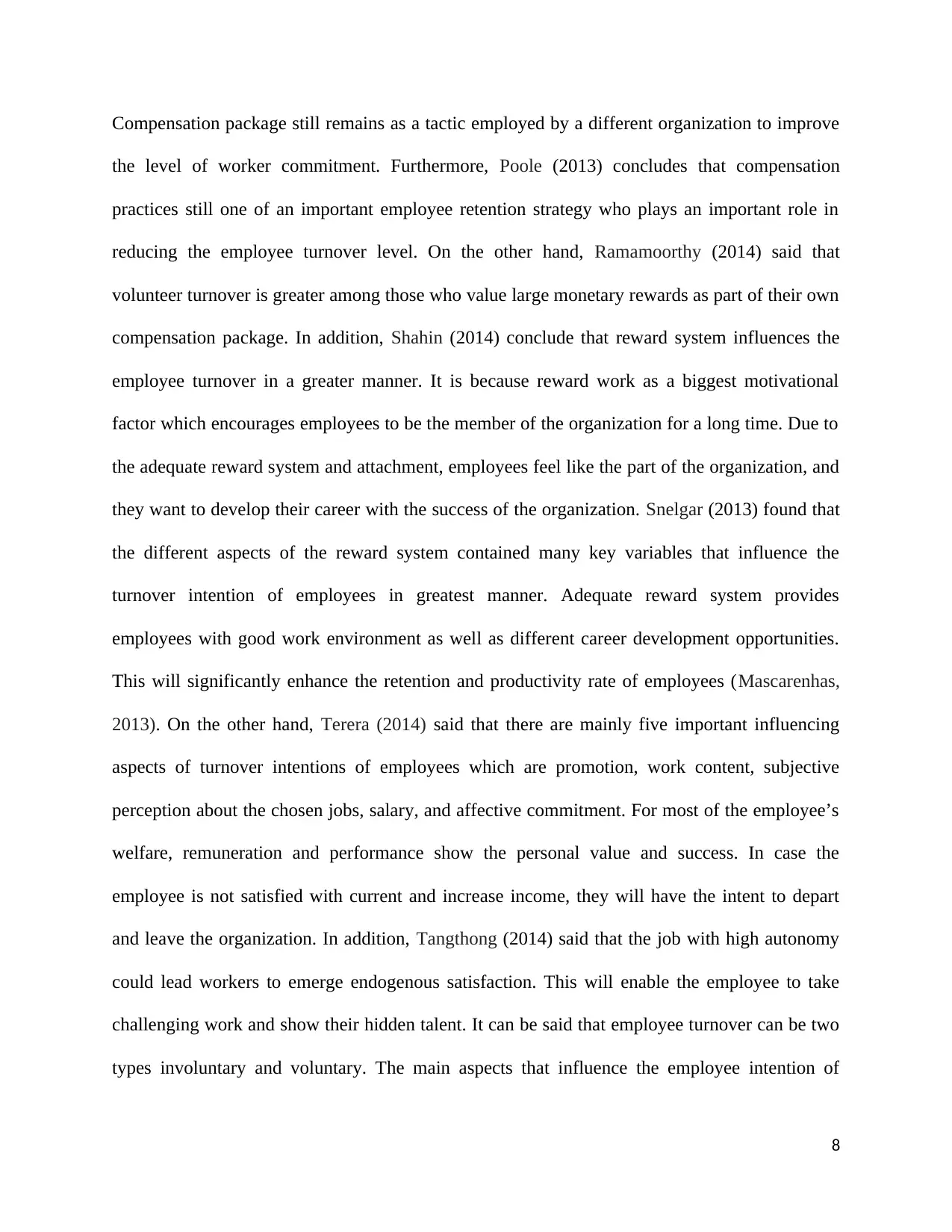
Compensation package still remains as a tactic employed by a different organization to improve
the level of worker commitment. Furthermore, Poole (2013) concludes that compensation
practices still one of an important employee retention strategy who plays an important role in
reducing the employee turnover level. On the other hand, Ramamoorthy (2014) said that
volunteer turnover is greater among those who value large monetary rewards as part of their own
compensation package. In addition, Shahin (2014) conclude that reward system influences the
employee turnover in a greater manner. It is because reward work as a biggest motivational
factor which encourages employees to be the member of the organization for a long time. Due to
the adequate reward system and attachment, employees feel like the part of the organization, and
they want to develop their career with the success of the organization. Snelgar (2013) found that
the different aspects of the reward system contained many key variables that influence the
turnover intention of employees in greatest manner. Adequate reward system provides
employees with good work environment as well as different career development opportunities.
This will significantly enhance the retention and productivity rate of employees (Mascarenhas,
2013). On the other hand, Terera (2014) said that there are mainly five important influencing
aspects of turnover intentions of employees which are promotion, work content, subjective
perception about the chosen jobs, salary, and affective commitment. For most of the employee’s
welfare, remuneration and performance show the personal value and success. In case the
employee is not satisfied with current and increase income, they will have the intent to depart
and leave the organization. In addition, Tangthong (2014) said that the job with high autonomy
could lead workers to emerge endogenous satisfaction. This will enable the employee to take
challenging work and show their hidden talent. It can be said that employee turnover can be two
types involuntary and voluntary. The main aspects that influence the employee intention of
8
the level of worker commitment. Furthermore, Poole (2013) concludes that compensation
practices still one of an important employee retention strategy who plays an important role in
reducing the employee turnover level. On the other hand, Ramamoorthy (2014) said that
volunteer turnover is greater among those who value large monetary rewards as part of their own
compensation package. In addition, Shahin (2014) conclude that reward system influences the
employee turnover in a greater manner. It is because reward work as a biggest motivational
factor which encourages employees to be the member of the organization for a long time. Due to
the adequate reward system and attachment, employees feel like the part of the organization, and
they want to develop their career with the success of the organization. Snelgar (2013) found that
the different aspects of the reward system contained many key variables that influence the
turnover intention of employees in greatest manner. Adequate reward system provides
employees with good work environment as well as different career development opportunities.
This will significantly enhance the retention and productivity rate of employees (Mascarenhas,
2013). On the other hand, Terera (2014) said that there are mainly five important influencing
aspects of turnover intentions of employees which are promotion, work content, subjective
perception about the chosen jobs, salary, and affective commitment. For most of the employee’s
welfare, remuneration and performance show the personal value and success. In case the
employee is not satisfied with current and increase income, they will have the intent to depart
and leave the organization. In addition, Tangthong (2014) said that the job with high autonomy
could lead workers to emerge endogenous satisfaction. This will enable the employee to take
challenging work and show their hidden talent. It can be said that employee turnover can be two
types involuntary and voluntary. The main aspects that influence the employee intention of
8
⊘ This is a preview!⊘
Do you want full access?
Subscribe today to unlock all pages.

Trusted by 1+ million students worldwide
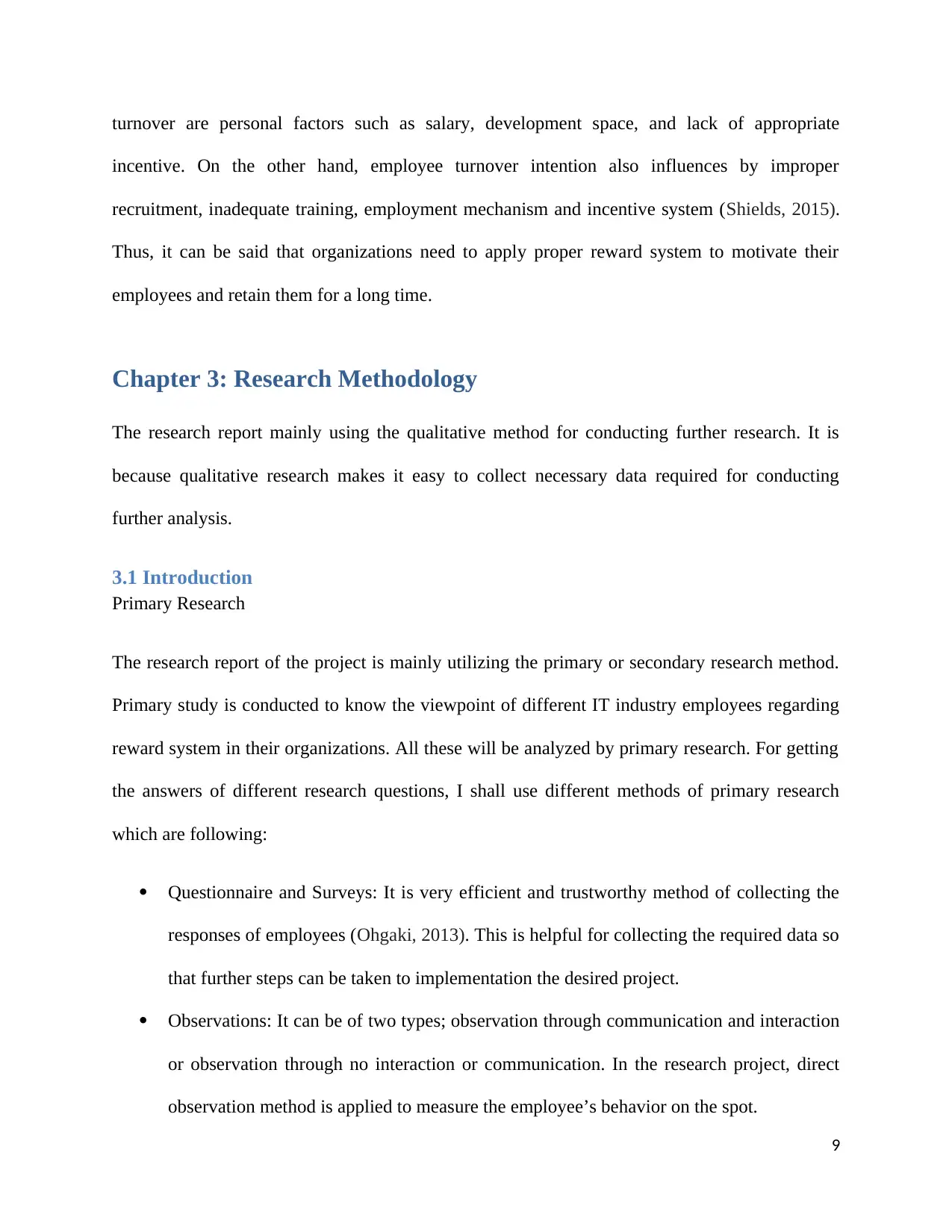
turnover are personal factors such as salary, development space, and lack of appropriate
incentive. On the other hand, employee turnover intention also influences by improper
recruitment, inadequate training, employment mechanism and incentive system (Shields, 2015).
Thus, it can be said that organizations need to apply proper reward system to motivate their
employees and retain them for a long time.
Chapter 3: Research Methodology
The research report mainly using the qualitative method for conducting further research. It is
because qualitative research makes it easy to collect necessary data required for conducting
further analysis.
3.1 Introduction
Primary Research
The research report of the project is mainly utilizing the primary or secondary research method.
Primary study is conducted to know the viewpoint of different IT industry employees regarding
reward system in their organizations. All these will be analyzed by primary research. For getting
the answers of different research questions, I shall use different methods of primary research
which are following:
Questionnaire and Surveys: It is very efficient and trustworthy method of collecting the
responses of employees (Ohgaki, 2013). This is helpful for collecting the required data so
that further steps can be taken to implementation the desired project.
Observations: It can be of two types; observation through communication and interaction
or observation through no interaction or communication. In the research project, direct
observation method is applied to measure the employee’s behavior on the spot.
9
incentive. On the other hand, employee turnover intention also influences by improper
recruitment, inadequate training, employment mechanism and incentive system (Shields, 2015).
Thus, it can be said that organizations need to apply proper reward system to motivate their
employees and retain them for a long time.
Chapter 3: Research Methodology
The research report mainly using the qualitative method for conducting further research. It is
because qualitative research makes it easy to collect necessary data required for conducting
further analysis.
3.1 Introduction
Primary Research
The research report of the project is mainly utilizing the primary or secondary research method.
Primary study is conducted to know the viewpoint of different IT industry employees regarding
reward system in their organizations. All these will be analyzed by primary research. For getting
the answers of different research questions, I shall use different methods of primary research
which are following:
Questionnaire and Surveys: It is very efficient and trustworthy method of collecting the
responses of employees (Ohgaki, 2013). This is helpful for collecting the required data so
that further steps can be taken to implementation the desired project.
Observations: It can be of two types; observation through communication and interaction
or observation through no interaction or communication. In the research project, direct
observation method is applied to measure the employee’s behavior on the spot.
9
Paraphrase This Document
Need a fresh take? Get an instant paraphrase of this document with our AI Paraphraser
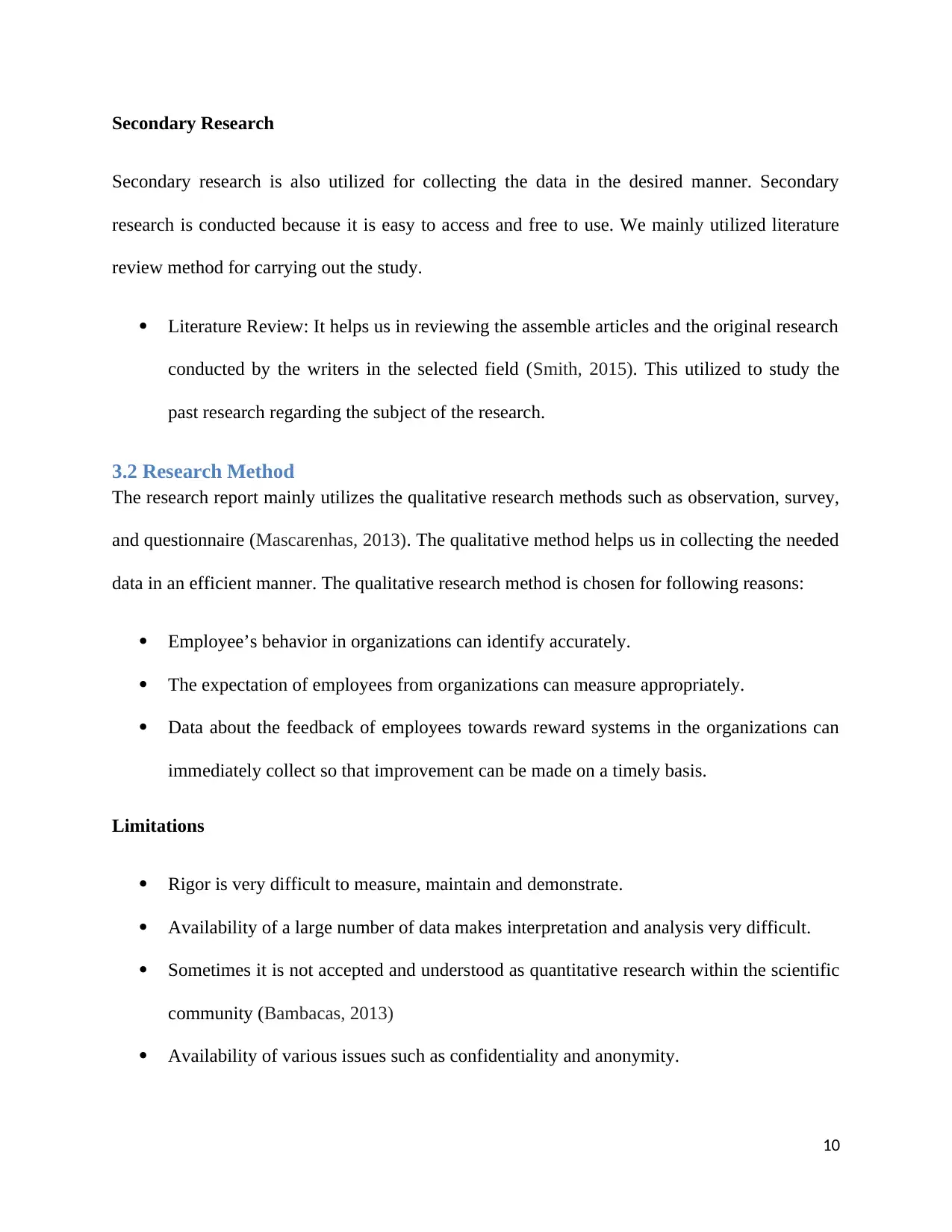
Secondary Research
Secondary research is also utilized for collecting the data in the desired manner. Secondary
research is conducted because it is easy to access and free to use. We mainly utilized literature
review method for carrying out the study.
Literature Review: It helps us in reviewing the assemble articles and the original research
conducted by the writers in the selected field (Smith, 2015). This utilized to study the
past research regarding the subject of the research.
3.2 Research Method
The research report mainly utilizes the qualitative research methods such as observation, survey,
and questionnaire (Mascarenhas, 2013). The qualitative method helps us in collecting the needed
data in an efficient manner. The qualitative research method is chosen for following reasons:
Employee’s behavior in organizations can identify accurately.
The expectation of employees from organizations can measure appropriately.
Data about the feedback of employees towards reward systems in the organizations can
immediately collect so that improvement can be made on a timely basis.
Limitations
Rigor is very difficult to measure, maintain and demonstrate.
Availability of a large number of data makes interpretation and analysis very difficult.
Sometimes it is not accepted and understood as quantitative research within the scientific
community (Bambacas, 2013)
Availability of various issues such as confidentiality and anonymity.
10
Secondary research is also utilized for collecting the data in the desired manner. Secondary
research is conducted because it is easy to access and free to use. We mainly utilized literature
review method for carrying out the study.
Literature Review: It helps us in reviewing the assemble articles and the original research
conducted by the writers in the selected field (Smith, 2015). This utilized to study the
past research regarding the subject of the research.
3.2 Research Method
The research report mainly utilizes the qualitative research methods such as observation, survey,
and questionnaire (Mascarenhas, 2013). The qualitative method helps us in collecting the needed
data in an efficient manner. The qualitative research method is chosen for following reasons:
Employee’s behavior in organizations can identify accurately.
The expectation of employees from organizations can measure appropriately.
Data about the feedback of employees towards reward systems in the organizations can
immediately collect so that improvement can be made on a timely basis.
Limitations
Rigor is very difficult to measure, maintain and demonstrate.
Availability of a large number of data makes interpretation and analysis very difficult.
Sometimes it is not accepted and understood as quantitative research within the scientific
community (Bambacas, 2013)
Availability of various issues such as confidentiality and anonymity.
10
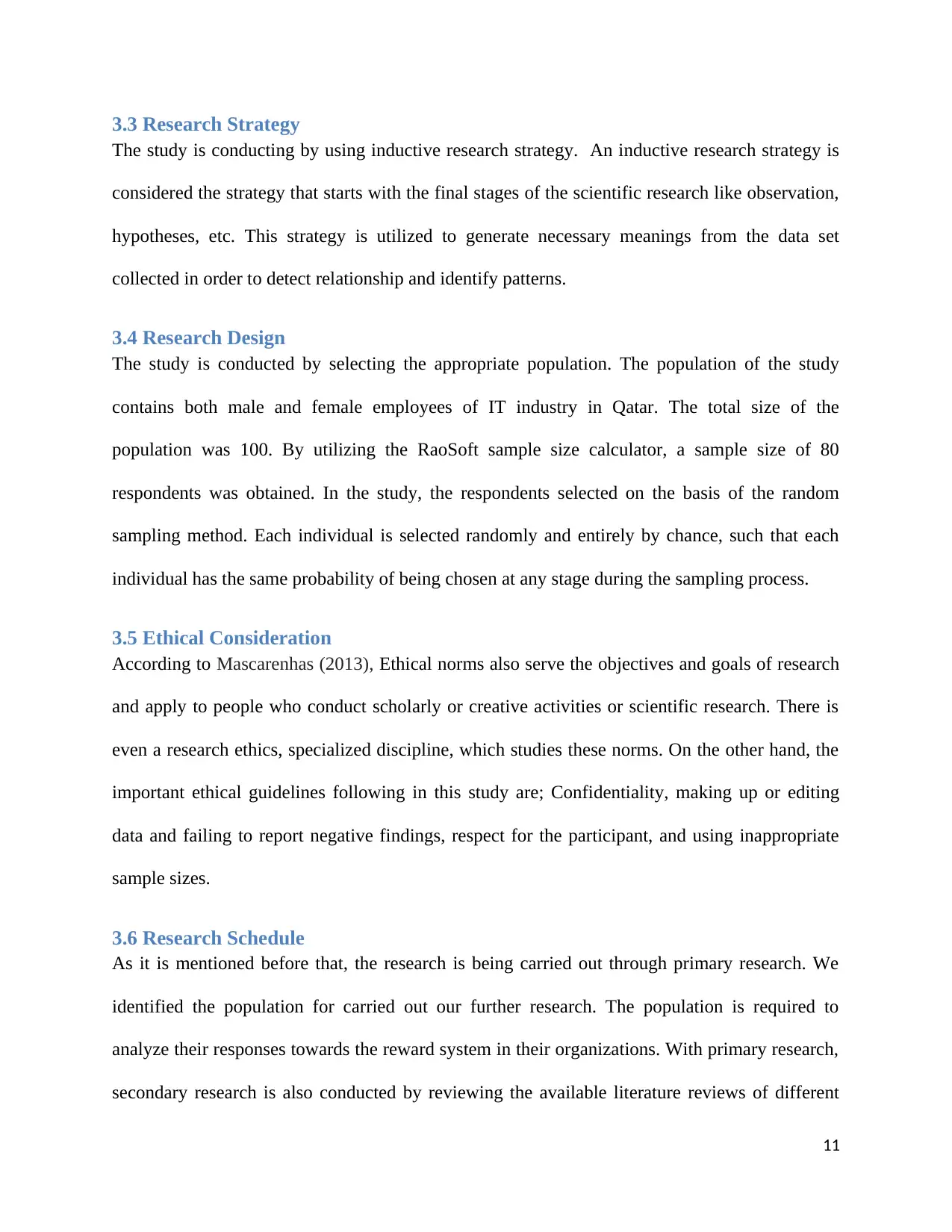
3.3 Research Strategy
The study is conducting by using inductive research strategy. An inductive research strategy is
considered the strategy that starts with the final stages of the scientific research like observation,
hypotheses, etc. This strategy is utilized to generate necessary meanings from the data set
collected in order to detect relationship and identify patterns.
3.4 Research Design
The study is conducted by selecting the appropriate population. The population of the study
contains both male and female employees of IT industry in Qatar. The total size of the
population was 100. By utilizing the RaoSoft sample size calculator, a sample size of 80
respondents was obtained. In the study, the respondents selected on the basis of the random
sampling method. Each individual is selected randomly and entirely by chance, such that each
individual has the same probability of being chosen at any stage during the sampling process.
3.5 Ethical Consideration
According to Mascarenhas (2013), Ethical norms also serve the objectives and goals of research
and apply to people who conduct scholarly or creative activities or scientific research. There is
even a research ethics, specialized discipline, which studies these norms. On the other hand, the
important ethical guidelines following in this study are; Confidentiality, making up or editing
data and failing to report negative findings, respect for the participant, and using inappropriate
sample sizes.
3.6 Research Schedule
As it is mentioned before that, the research is being carried out through primary research. We
identified the population for carried out our further research. The population is required to
analyze their responses towards the reward system in their organizations. With primary research,
secondary research is also conducted by reviewing the available literature reviews of different
11
The study is conducting by using inductive research strategy. An inductive research strategy is
considered the strategy that starts with the final stages of the scientific research like observation,
hypotheses, etc. This strategy is utilized to generate necessary meanings from the data set
collected in order to detect relationship and identify patterns.
3.4 Research Design
The study is conducted by selecting the appropriate population. The population of the study
contains both male and female employees of IT industry in Qatar. The total size of the
population was 100. By utilizing the RaoSoft sample size calculator, a sample size of 80
respondents was obtained. In the study, the respondents selected on the basis of the random
sampling method. Each individual is selected randomly and entirely by chance, such that each
individual has the same probability of being chosen at any stage during the sampling process.
3.5 Ethical Consideration
According to Mascarenhas (2013), Ethical norms also serve the objectives and goals of research
and apply to people who conduct scholarly or creative activities or scientific research. There is
even a research ethics, specialized discipline, which studies these norms. On the other hand, the
important ethical guidelines following in this study are; Confidentiality, making up or editing
data and failing to report negative findings, respect for the participant, and using inappropriate
sample sizes.
3.6 Research Schedule
As it is mentioned before that, the research is being carried out through primary research. We
identified the population for carried out our further research. The population is required to
analyze their responses towards the reward system in their organizations. With primary research,
secondary research is also conducted by reviewing the available literature reviews of different
11
⊘ This is a preview!⊘
Do you want full access?
Subscribe today to unlock all pages.

Trusted by 1+ million students worldwide
1 out of 19
Related Documents
Your All-in-One AI-Powered Toolkit for Academic Success.
+13062052269
info@desklib.com
Available 24*7 on WhatsApp / Email
![[object Object]](/_next/static/media/star-bottom.7253800d.svg)
Unlock your academic potential
Copyright © 2020–2025 A2Z Services. All Rights Reserved. Developed and managed by ZUCOL.



